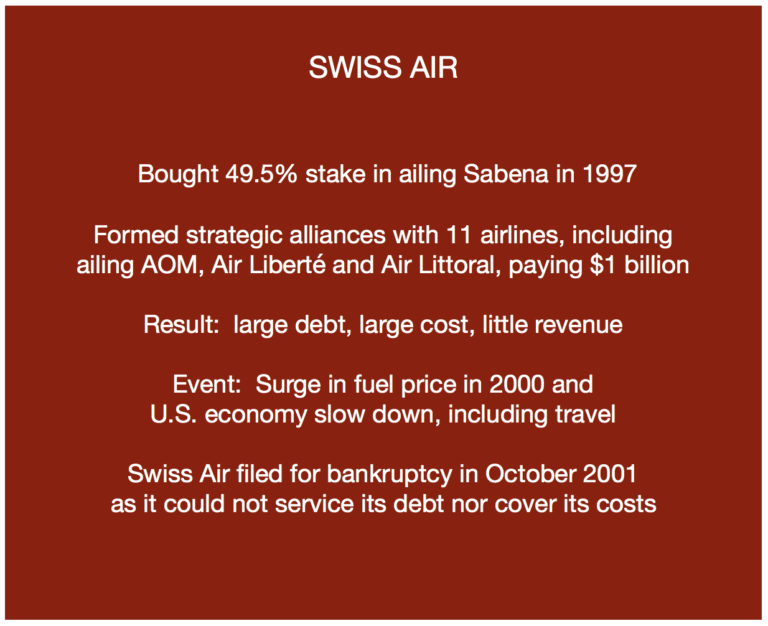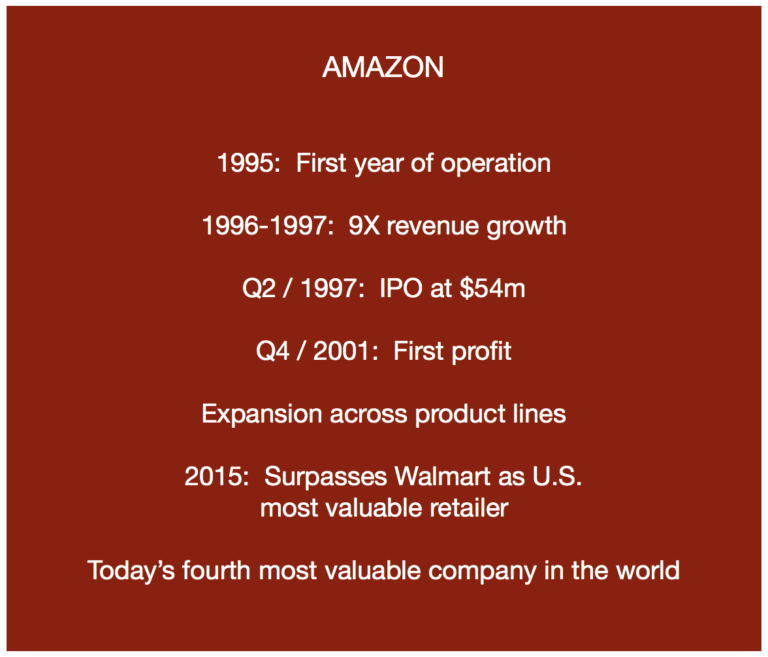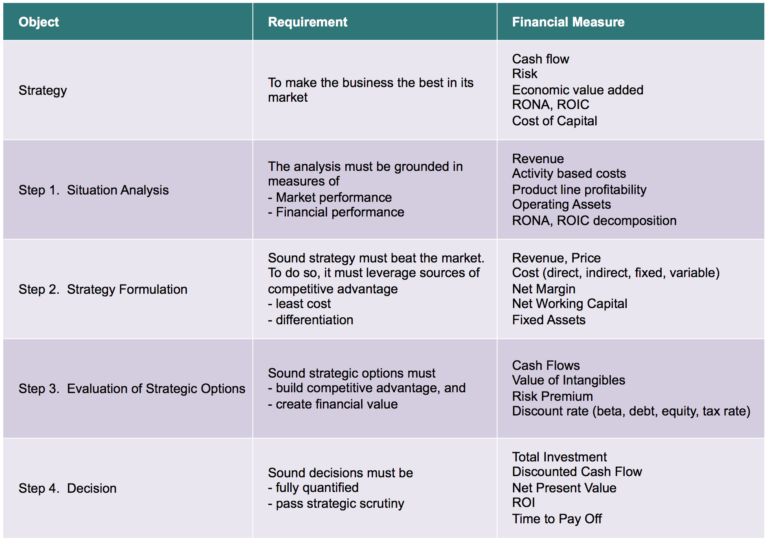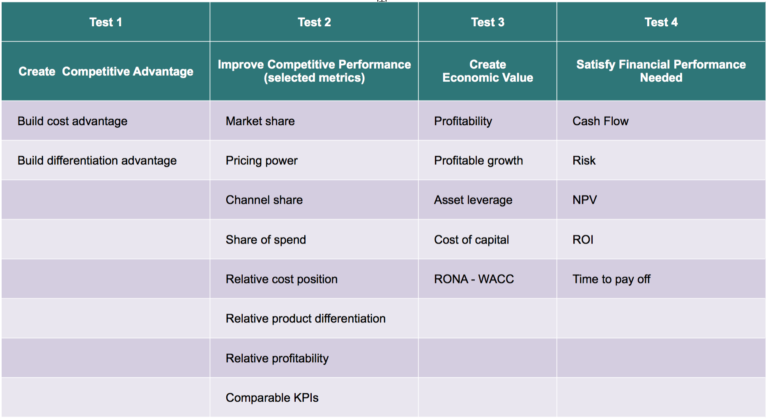A natural tension exists between strategic management and financial management of a company. Both aim at maximizing the value created by the firm but differ in their approach. Strategic management considers the systematic examination of a company’s basis for long-term success, including trade-offs of short-to-medium term gains for long-term success. Financial management operates on the notion that all potential projects available to the firm get judged by their cash flows and profitable net present value.
For top management, this tension means dealing with a broad range of challenges and mediating between divergent views that ultimately shape the organization and its performance.
STRATEGIC THINKING
Business strategy is about making a particular business the best in its market. The objective is to serve customers profitably and better than the competition over the next 3 to 5 years. This requirement means building competitive advantage as a way to provide sustainable and profitable business growth and fend off competition at the same time. Therefore, a strategy must be grounded on measures of market performance, including customers and competitors. It must also include measures of financial performance to achieve sustainable, profitable growth.
The development of strategy typically involves four steps:
- First is an analysis of the current situation of the business
- Second is the formulation of strategy, a plan to serve customers profitably and beat the competition, by leveraging competitive advantage
- Third is the evaluation of potential strategic options that vary in scope, level of investment, and risk
- Fourth is the decision of which strategic option to pursue
Corporate strategy looks at the portfolio composition and focuses on other variables, but hinges on competitive advantage nonetheless.
FINANCIAL THINKING
Financial thinking starts with capital markets. In a nutshell, companies go to capital markets to seek funds from investors. They invest, but if they don’t like what the company is doing, they can move their money somewhere else. As a result, capital markets have a large impact on the valuation of the firm. It follows that top management needs to take into consideration financial stakeholders’ interests. Financial thinking then takes into account the perspectives of capital markets and adapts to the majority view of analysts and investors. These views form the basis for internal company decisions about what actions to take.
Briefly, the procedure is as follows:
- All potential projects available to the firm are expressed in terms of their free cash flows
- The capital rate for each project is determined based on its inherent risk
- The net present value is calculated based on the forecasted time horizon
This approach provides the basis for deciding which projects to pursue.
THE LIMITATIONS OF STRATEGY (WITHOUT CORPORATE FINANCE)
One the CFO’s primary concerns is managing risk. This task is complex because risk can originate from many diverse initiating events. Examples include foreign currency spikes, faulty products, cyber attacks, foreign exchange spikes, oil price shocks, economic swings, digital business disruptions, cash deficit, volatile commodity prices, just to name a few. A convenient classification of risk includes the following:
- Operational risk
- Market risk
- Business risk
- Financial risk
- Regulatory risk
- Cybersecurity
Some of these classes of risk are easier to predict and protect. Others are not. As it relates to strategy, it is important to know that even the best strategies can inadvertently expose the firm to risk and severely damage the company. Therefore, the involvement of the CFO becomes essential for at least two reasons: (1) protect the company against any inadvertent risk, and (2) balance short-term earnings against long-term prospects.
Case Example: Swiss Air
Swiss Air’s rapid expansion and lack of risk management brought the company to bankruptcy.

THE LIMITATIONS OF CORPORATE FINANCE (WITHOUT STRATEGY)
A financial test determines the merit of an investment based on its financial performance, but it doesn’t address where the investment will position the firm vis-a-vis the competition or the sustainability of the company’s market position. How would a financial approach deal with the following projects?
- Technological breakthrough
- New product development
- New market entry
- Market development
- Distribution channel development
- Business model redefinition
- Strategic acquisitions
- Strategic alliances
Without a strategy, a purely financial approach to any of these projects will most likely fail the project. That’s because, beyond financial performance, strategy concerns market performance. Sound strategy drives value creation by building competitive advantage, which is not reflected in financial measures. Market share, pricing power, share of distribution, relative cost position, sales force effectiveness, uniqueness of technology, supply chain effectiveness, operational effectiveness, operational efficiencies – these are examples of drivers of competitive position and sources of value that a financial test will miss.
As a result of using solely financial tests, companies in a strong financial position will inevitably find themselves in a deteriorating strategic position. Typical signals of a weakening strategic position include market share erosion, customer defections, price deterioration, stagnant growth, lack of future growth opportunities, unfavorable relative cost position, disproportionate increase in the cost structure, low-turning assets, an absence of advantage, inability to defend against the competition, and overall loss of business value.
Case Example: Amazon
Based purely on financial measures, Amazon would never have survived.

FINDING A BALANCE: HOW STRATEGY AND CORPORATE FINANCE WORK TOGETHER
The roles of strategy and finance come into sharp focus over decisions of resource allocation. Initiatives such as investing in innovation, expanding into new markets, cutting unproductive business lines, rationalizing production overcapacity, M&A deals, divestments, and strategic alliances are just some of the investments that require hard decisions. CSOs and CFOs each contribute insights that make for a stronger tie between strategy and capital allocation.
When strategy analysis is grounded in specific financial measures, strategy becomes specific, measurable, time-bound, actionable, and results oriented.
TABLE 1. FINANCIAL MEASURES OF STRATEGY

Ultimately, strategic investments need to pass four tests to be effective, including the following:
- Does the investment leverage and build the company’s competitive advantage?
- How does it improve the firm’s competitive position?
- How much value will the investment create? Over what time horizon?
- Will it deliver the financial performance needed?
When capital investment decisions are grounded in strategic and financial measures, tests become self-apparent.
TABLE 2. TESTS FOR STRATEGIC INVESTMENTS

WHAT COMPANIES STAND TO GAIN
In the best organizations, the strategy and finance functions work together in executing these tests, as each provides valuable expertise. The precision established by the tests improves the quality of information and the soundness of the investment decision. Some of the benefits include the following:
- Shifting from a mindset of short-term financial efficiency to sustainable value creation for the future
- Connecting business strategy, value creation, and financial performance
- The ability to act on the drivers of competitive performance
- The capacity to evaluate strategic investments objectively and thoroughly from both angles, strategic and financial – a competence particularly important for costly initiatives such as M&A deals, divestments, and strategic alliances, but also for organic growth initiatives, cost reduction programs, and asset restructuring
- Greater depth and transparency of analysis, which drive better decision-making and greater confidence in the decisions made
- De-bias decision making
- The ability to explain the business strategy, corresponding investments, and value openly and precisely to various stakeholders, including the board, executive management, shareholders, partners, and investors.
Companies where CSOs and CFOs work together improve their odds of successful strategies and superior financial returns.

